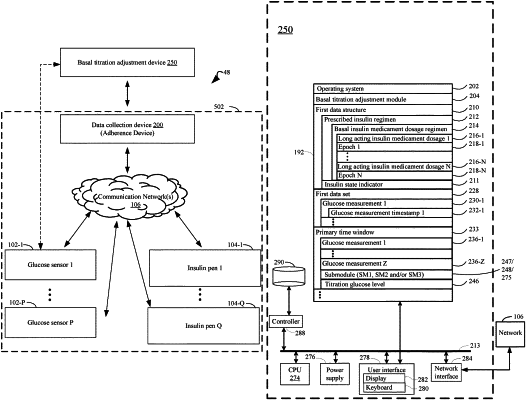| CPC A61M 5/1723 (2013.01) [G16H 20/17 (2018.01); A61M 2005/14208 (2013.01); A61M 2005/1726 (2013.01); A61M 2205/52 (2013.01)] | 4 Claims |

|
1. A basal titration adjustment device for autonomously adjusting a long acting insulin medicament dosage in a prescribed basal insulin regimen for a subject, wherein the device comprises one or more processors and a memory, the memory comprising:
a prescribed insulin regimen including a basal insulin medicament dosage regimen, wherein the basal insulin medicament dosage regimen specifies the amount of long acting insulin medicament dosage, and instructions that, when executed by the one or more processors, perform a method of:
(A) obtaining, a first data set, the first data set comprising a plurality of glucose measurements of the subject taken over a time course and, for each respective glucose measurement in the plurality of glucose measurements, a corresponding timestamp representing when in the time course the respective glucose measurement was made;
(B) obtaining a titration glucose level being the glucose level used as input to an algorithm for maintaining or adjusting the long acting insulin medicament dosage, wherein the titration glucose level is based on a titration subset of small glucose measurements, by:
(i) obtaining a primary time window within the time course defining the period of time comprising the glucose measurements in the first data set to be used for identifying the titration subset of small glucose measurements and for obtaining the titration glucose level for the primary time window, wherein each of the glucose measurements has a timestamp within the primary time window,
(ii) identifying the titration subset of small glucose measurements, identified as a subset of small glucose measurements within the primary time window,
(iii) obtaining the titration glucose level, computed as a measure of central tendency of the titration subset of small glucose measurements, wherein the measure of central tendency represents a measure of small glucose measurements for the primary time window, and
(iv) associating the titration glucose level with the measure of central tendency, by assigning the value of measure of central tendency to the titration glucose level;
(C) adjusting or maintaining the long acting insulin medicament dosage based upon the obtained titration glucose level, wherein the obtaining the titration glucose level, in step B, further comprises:
selecting one of the following evaluation modes:
(B1) for the primary time window, in a first evaluation mode, (i) obtaining an integer defining the number of glucose measurements to be selected for the subset of glucose measurements, (ii) identifying and selecting the titration subset of small glucose measurements as a subset of smallest glucose measurements, by identifying and selecting the smallest glucose measurements within the primary time window, and ensuring that the number of measurements within the titration subset of small glucose measurements equals the obtained integer, (iii) obtaining the measure of central tendency as a first glucose measure of central tendency, and computed as a measure of central tendency of the glucose measurements within the subset of small glucose measurements, and
associating the titration glucose level with the first glucose measure of central tendency, or
(B2) for the primary time window, in a second evaluation mode, obtaining a plurality of contemporaneously overlapping secondary time windows within the primary time window, wherein each secondary time window comprises a subset of overlapping glucose measurements being a subset of the glucose measurements in the primary time window,
for each secondary time window within the plurality of secondary time windows, computing a corresponding second glucose measure of central tendency, and thereby obtaining a plurality of second glucose measures of central tendency, wherein each respective second glucose measure of central tendency is computed as a measure of central tendency of the glucose measurements within the corresponding secondary time window, and thereby obtaining a moving period of a measure of central tendency across the glucose measurements in the primary time window,
for the plurality of second glucose measures of central tendency, identifying a smallest second glucose measure of central tendency as the smallest second glucose measure of central tendency within the plurality of second glucose measures of central tendency, whereby the titration subset of small glucose measurements is identified as the subset comprising the glucose measurements within the secondary time window corresponding to the smallest second glucose measure of central tendency, and
associating the titration glucose level with the smallest second glucose measure of central tendency.
|